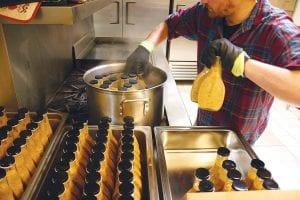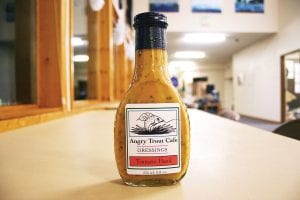Fans of the Angry Trout Café’s fare will recognize a familiar treat in a new package in local stores. The maple mustard, tomato basil, and barbecue dressings that accompany the popular downtown Grand Marais restaurant’s meals will be available to shoppers in 8 oz. glass bottles.
Elliot Noyce, an employee of the restaurant, has been heading the upstart project. He said it began a year and a half ago when he got the blessing of Barb LaVigne, co-owner of the Angry Trout, who provided financial backing to the effort. Since then it’s been a matter of getting the dressings approved for food safety through the University of Nebraska’s Food Process Authority. After getting the green light that the product would be shelf-stable and safe for consumption, Noyce began to start production roughly two months ago.
Noyce, along with a few other employees, rents out the Community Center’s kitchen every Sunday to produce up to 20 cases of each dressing. Each case contains 12 bottles.
The process begins by mixing large batches of each dressing and then hand-filling every bottle. After that, the team “essentially cans” the dressings by putting the filled bottles in a bath of boiling water. This process seals the cap onto the bottle and extends the shelf life of the dressing. Then comes labeling the bottles and packaging them in cases. Afterward they’re stored at the Angry Trout restaurant for later distribution.
The dressings are currently sold locally at the Cook County Whole Foods Co-op, Johnson’s, and The Trading Post. But Noyce thinks there is room to expand.
“We’re hoping to get picked up by Co-op Partners Warehouse (CPW) which means our product would be sold in the Cities.”
CPW supplies 380 businesses and groceries in seven states. By expanding distribution they can then expand production, which would mean the need for more labor.
“It’d be awesome to have 15 people or so putting in 20 hours a week,” Noyce said. And that is the ultimate goal of selling the Angry Trout Café’s dressings, Noyce mentioned – to create more jobs in an area where many seasonal employees find themselves without work during the winter months.
“We’re not looking to necessarily make a profit. We’re looking to create more year-round jobs,” Noyce said.




Leave a Reply